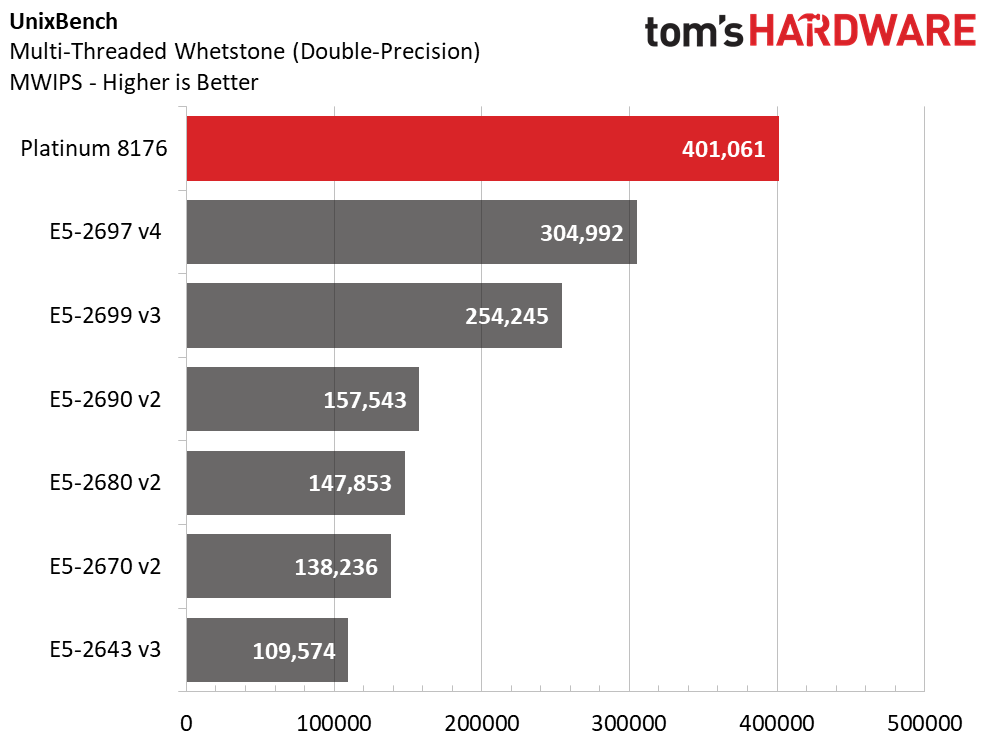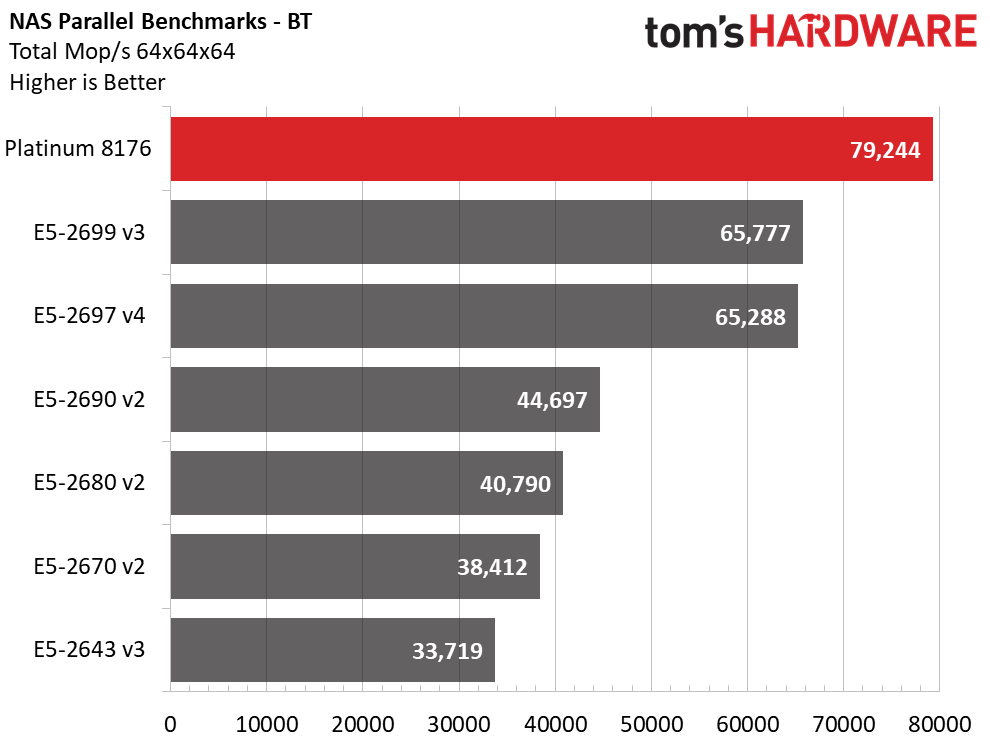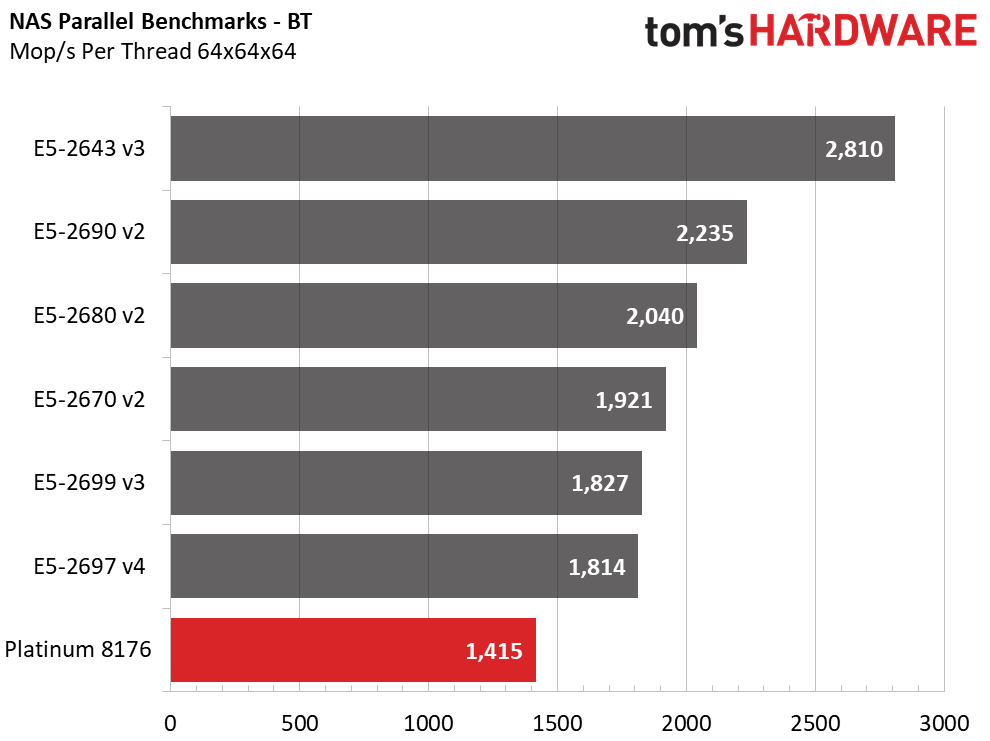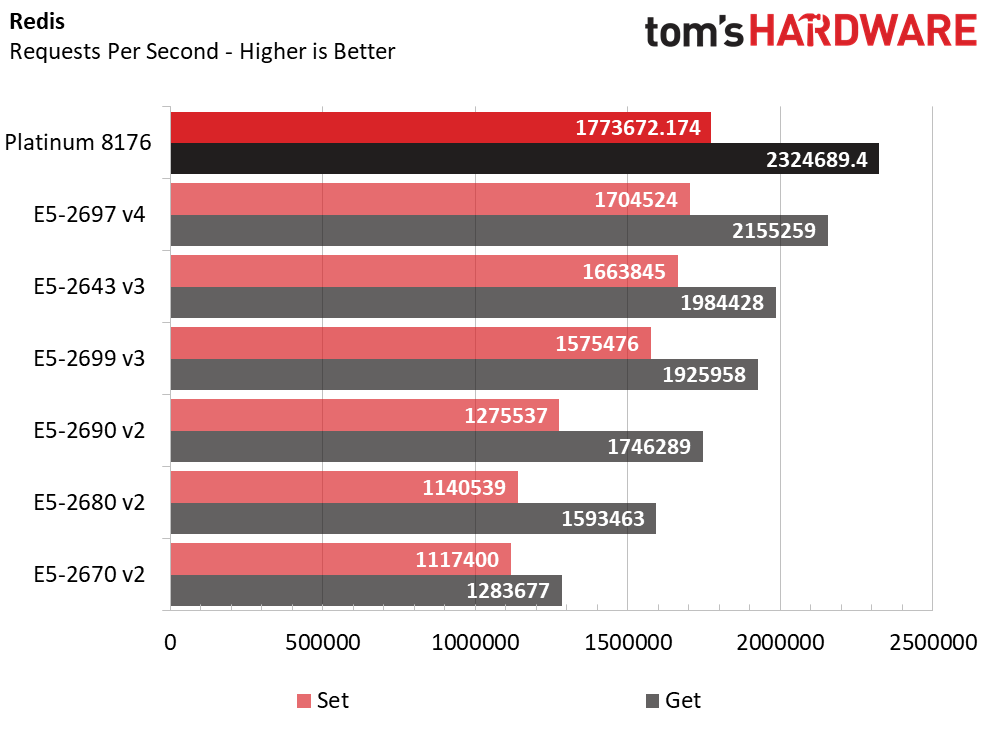Intel Xeon Platinum 8176 Scalable Processor Review
Why you can trust Tom's Hardware
Benchmarks, Part 1
Unix Bench 5.1.3
Unix Bench is an open source GPLv2-licensed suite that originated in 1983 at Mondash University. Byte Magazine then updated and expanded the set of metrics. It includes nine benchmarks that quantify various aspects of system performance, but we focus on Dhrystone and Whetstone specifically. The former isolates string handling; there are no floating-point operations. Whetstone measures the speed and efficiency of floating-point operations typically employed in scientific applications.




The Xeon Platinum 8176 provides a nice single-threaded boost to integer operations compared to the previous-generation E5-2697 v4. We also observe a notable increase in the single-threaded Whetstone test compared Intel's previous generation. Also, the E5-2643 comes close with its 3.4 GHz base and 3.7 GHz Turbo Boost clock rate.
The Platinum takes an easy lead in both tests when we spread the workload across all 28 cores. The E5-2697 v4 is its nearest competitor, but a 10-core deficit is downright unforgiving compared to the Platinum 8176. Whetstone addresses a minuscule amount of data that tends to reside entirely in L1 cache.
NAMD Scalable Molecular Dynamics
NAMD is a parallel molecular dynamics workload that performs high-performance simulations of large biomolecular systems. It's designed to test the boundaries of parallel computing by scaling up to 500,000 cores. The Theoretical and Computational Biophysics Group at the University of Illinois at Urbana-Champaign developed and maintains the project, which is the recipient of several prestigious awards.
Core counts reign supreme in this floating-point-heavy test. The Platinum 8176 leverages its hefty armada of cores to take an easy lead over the rest of the field. Like many of the multi-threaded tests, this is a one-sided competition. We'd need a 28-core Broadwell-EP for a fairer match-up, but one doesn't exist.
NAS Parallel Benchmarks
The NAS Parallel Benchmarks (NPB) are a set of programs developed by the NASA Advanced Supercomputing Division to evaluate the performance of parallel supercomputers. The suite characterizes Computational Fluid Dynamics (CFD) applications, and NASA designed it to measure performance from smaller CFD applications up to "embarrassingly parallel" operations. The FT test characterizes a 3D partial differential equation using Fast Fourier Transform, while BT measures Block Tri-Diagonal solver performance.




The E5-2699 v3 and E5-2697 v4 both feature 18 Hyper-Threaded cores, so it isn't surprising to find them closely matched. The Platinum 8176 doesn't provide a performance increase commiserate with its hefty core advantage because other factors, such as clock rates, also come into play. In either case, the new processor is still quite a bit faster.
Get Tom's Hardware's best news and in-depth reviews, straight to your inbox.
Due to its lower frequency, the 8176 provides fewer M/ops (Millions of Operations Per Second) per thread. That's a measure of per-core performance. The rest of the field aligns nicely based on clock rate, it appears. Provided you have a big core count advantage in your favor, the lower M/ops per thread value isn't as important for highly-parallelized workloads.
Redis
REmote DIctionary Server (Redis) is a popular in-memory data structure store that is used as a database, cache, and message broker. It's dependent on both CPU performance and memory bandwidth. Redis is open source (BSD-licensed) software.
Memory throughput plays a big role in this test, as evidenced by the DDR3-equipped v2 models at the bottom of the chart. Redis is a single-threaded workload, so its indicative of per-core memory throughput and performance. That's why the six-core E5-2643 v3s lead over the 10-core E5-2699 v3. In light of Platinum's vastly improved memory throughput, it appears a lower operating frequency hinders the Platinum 8176. A multi-threaded in-memory database would extract much more performance from the Platinum's memory throughput capabilities.
Open SSL
SSL (Secure Sockets Layer) is the go-to technology for securing encrypted links between a server and client. It's an important protocol for every level of the Web in today's security-conscious climate.


Intel worked diligently on accelerating encryption/decryption from several angles, as we measured in the Core i9-7900X Review. Our Platinum-based test system comes outfitted with Intel's QuickAssist Technology, which boosts performance in a range of encryption/decryption tasks.
MORE: Best CPUs
MORE: Intel & AMD Processor Hierarchy
MORE: All CPU Content
Current page: Benchmarks, Part 1
Prev Page Test Platforms & How We Test Next Page Benchmarks, Part 2
Paul Alcorn is the Editor-in-Chief for Tom's Hardware US. He also writes news and reviews on CPUs, storage, and enterprise hardware.
-
the nerd 389 Do these CPUs have the same thermal issues as the i9 series?Reply
I know these aren't going to be overclocked, but the additional CPU temps introduce a number of non-trivial engineering challenges that would result in significant reliability issues if not taken into account.
Specifically, as thermal resistance to the heatsink increases, the thermal resistance to the motherboard drops with the larger socket and more pins. This means more heat will be dumped into the motherboard's traces. That could raise the temperatures of surrounding components to a point that reliability is compromised. This is the case with the Core i9 CPUs.
See the comments here for the numbers:
http://www.tomshardware.com/forum/id-3464475/skylake-mess-explored-thermal-paste-runaway-power.html -
Snipergod87 Reply19926080 said:Do these CPUs have the same thermal issues as the i9 series?
I know these aren't going to be overclocked, but the additional CPU temps introduce a number of non-trivial engineering challenges that would result in significant reliability issues if not taken into account.
Specifically, as thermal resistance to the heatsink increases, the thermal resistance to the motherboard drops with the larger socket and more pins. This means more heat will be dumped into the motherboard's traces. That could raise the temperatures of surrounding components to a point that reliability is compromised. This is the case with the Core i9 CPUs.
See the comments here for the numbers:
http://www.tomshardware.com/forum/id-3464475/skylake-mess-explored-thermal-paste-runaway-power.html
Wouldn't be surprised if they did but also wouldn't be surprised in Intel used solder on these. Also it is important to note that server have much more airflow than your standard desktop, enabling better cooling all around, from the CPU to the VRM's. Server boards are designed for cooling as well and not aesthetics and stylish heat sink designs -
InvalidError Reply
That heat has to go from the die, through solder balls, the multi-layer CPU carrier substrate, those tiny contact fingers and finally, solder joints on the PCB. The thermal resistance from die to motherboard will still be over an order of magnitude worse than from the die to heatsink, which is less than what the VRM phases are sinking into the motherboard's power and ground planes. I wouldn't worry about it.19926080 said:the thermal resistance to the motherboard drops with the larger socket and more pins. This means more heat will be dumped into the motherboard's traces.
-
bit_user ReplyThe 28C/56T Platinum 8176 sells for no less than $8719
Actually, the big customers don't pay that much, but still... For that, it had better be made of platinum!
That's $311.39 per core!
The otherwise identical CPU jumps to a whopping $11722, if you want to equip it with up to 1.5 TB of RAM instead of only 768 GB.
Source: http://ark.intel.com/products/120508/Intel-Xeon-Platinum-8176-Processor-38_5M-Cache-2_10-GHz -
Kennyy Evony jowen3400 21 minutes agoReply
Can this run Crysis?
Jowen, did you just come up to a Ferrari and ask if it has a hitch for your grandma's trailer? -
bit_user Reply
I wouldn't trust a $8k server CPU I got for $100. I guess if they're legit pulls from upgrades, you could afford to go through a few @ that price to find one that works. Maybe they'd be so cheap because somebody already did cherry-pick the good ones.19927274 said:W8 on ebay\aliexpress for $100
Still, has anyone had any luck on such heavily-discounted server CPUs? Let's limit to Sandybridge or newer. -
JamesSneed Reply19927188 said:The 28C/56T Platinum 8176 sells for no less than $8719
Actually, the big customers don't pay that much, but still... For that, it had better be made of platinum!
That's $311.39 per core!
The otherwise identical CPU jumps to a whopping $11722, if you want to equip it with up to 1.5 TB of RAM instead of only 768 GB.
Source: http://ark.intel.com/products/120508/Intel-Xeon-Platinum-8176-Processor-38_5M-Cache-2_10-GHz
That is still dirt cheap for a high end server. An Oracle EE database license is going to be 200K+ on a server like this one. This is nothing in the grand scheme of things.
-
bit_user Reply
A lot of people don't have such high software costs. In many cases, the software is mostly home-grown and open source (or like 100%, if you're Google).19927866 said:An Oracle EE database license is going to be 200K+ on a server like this one. This is nothing in the grand scheme of things.

